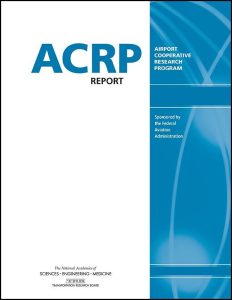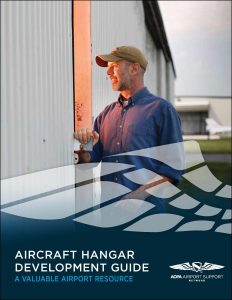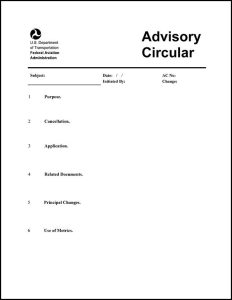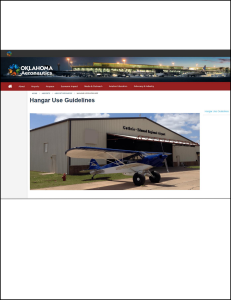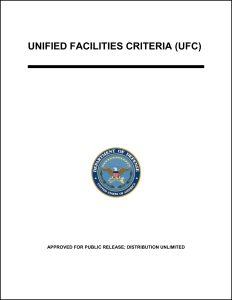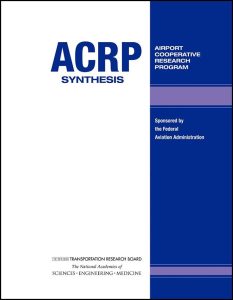To narrow the library of airside resources, use the filter boxes or airport map below or search box above.
Click an item below to expand.
Resources Matching Your Search
2016
This standard helps safeguard life and property through requirements for the proper construction and fire protection of aircraft hangars used for aircraft storage, maintenance, or related activities. This is a paid resource available in print for $54.50 and in PDF for $58.50.
2011
ACRP Report 47 discusses the key issues associated with developing and leasing available airport land and summarizes best practices from the perspective of the airport sponsor. The report presents a diverse set of case studies that show the approaches that airports have taken to develop and lease property for aeronautical uses (e.g., aircraft maintenance facilities, fixed-base operator facilities, hangars, training centers, and cargo facilities) and non-aeronautical uses (e.g., light industrial and commercial facilities).
2006
This guide is designed to help airports develop a project management strategy to successfully plan, design, and complete a new hangar development project. This resource will cover project scoping, financial justification, preliminary design and budgeting, funding, approvals, construction, and moving in. It will also help anticipate the challenges that can affect a hangar project.
2013
This publication also provides airport owners and operators with information and guidelines for a standardized T-hangar bid package. This includes financial information to assist with the various stages of T-hangar development. This document also provides generic standard specifications and minimum requirements for T-hangar construction that can be tailored to account for differences in local conditions, laws, or regulations, and unique requirements of an airport, based on its operations and conditions.
2015
This advisory circular (AC) provides guidance for the preparation of master plans for airports that range in size and function, from small general aviation to large commercial service facilities. The intent of this AC is to foster a flexible approach to master planning that directs attention and resources to critical issues. The scope of each master plan must be tailored to the individual airport under evaluation.
2015
This advisory circular (AC) provides guidance for airport sponsors in the selection and engagement of architectural, engineering, and planning consultants. It also discusses services that normally would be included in an airport grant project, types of contracts for these services, contract format and provisions, and guidelines for determining the reasonableness of consultant fees.
2017
This website provides hanger use guidelines and frequently asked questions and answers on FAA policy on the use of hangars at obligated airports.
2019
ACRP Report 16, second edition, is designed to help airport practitioners, owners, operators, managers, and policymakers of small airports, who may have varying degrees of experience and backgrounds, to fulfill their responsibilities in such areas as financial management, oversight of contracts and leases, safety and security, noise impacts, community relations, compliance with federal and state obligations, facility maintenance, and capital improvements. The first edition has been edited and reformatted for currency, relevance, and usability and updated with additional information and new subject areas (e.g., unmanned aircraft systems, geographic information systems, digital notices to airmen, social media, and federal and state obligations). Also, hyperlinks to many of the documents and resources mentioned in this report, such as ACRP publications, industry sources, and sample checklists, have been collected into ACRP WebResource 6: Resources for Managing Small Airports.
2020
This manual provides standardized airfield, heliport, and airspace criteria for the geometric layout, design, and construction of runways, helipads, taxiways, aprons, landing zones (LZs), short takeoff and vertical landing (STOVL) facilities, unmanned aircraft system (UAS) facilities, and related permanent facilities to meet sustained operations for U.S. Army, Navy, Air Force, and Marine Corps airfields.
2020
This document provides instructions to the FAA’s Airports District Offices (ADO) and Regional Offices of Airports as well as states participating in FAA’s State Block Grant program regarding changes in legal authority under the FAA Reauthorization Act of 2018. This document explains the internal process for reviewing airport layout plan (ALP) changes when new development is proposed by an airport sponsor and provides instructions on release of federal grant obligations and the circumstances under which these actions are necessary. Additionally, this document provides information on the way in which environmental review under the National Environmental Policy Act (NEPA) should address the new limitations on FAA’s regulatory authorities. These are internal instructions for implementation of FAA’s statutorily revised authorities over use of airport property and do not require new actions from airport sponsors.
2009
ACRP Report 21 describes various project delivery methods for major airport capital projects. The report evaluates the impacts, advantages, and disadvantages of these various project delivery methods. The project delivery methods discussed include design-bid-build, construction manager at risk, and design-build. The report offers a two-tiered project delivery selection framework that may be used by owners of airport projects to evaluate the pros and cons of each delivery method and select the most appropriate method for their project.
2011
ACRP Report 51 provides a methodology that airports can use to support their request for modification of standards. It is intended to be used in circumstances where the design criteria for separations between taxiways/taxilanes and (1) other taxiways/taxilanes and (2) fixed or movable objects as well as separations between taxiways and runways cannot be met. This risk-based methodology will be useful to airport staff and their consultants as they assess the risks associated with non-standard separations at existing constrained airports, where the standards cannot be practicably met.
2016
ACRP Synthesis 78 compiles information about current continuity planning practices at airports of different types and sizes and determines how they can be effectively applied to smaller airports to maintain resilient operational and business capacity during a disruption, regardless of the cause. Business continuity planning is the process of developing a plan for operating essential operational and business functions in the face of a disruption caused by any types of emergencies, incidents, or events. This study addresses business continuity planning for emergency and non-emergency disruptions.
2009
ACRP Web-Only Document 6 reviews pertinent literature and research findings related to various project delivery methods for airport projects. It contains definitions of project delivery methods and discusses the existing selection approaches commonly used by airports. The web-only document is a companion to ACRP Report 21.

